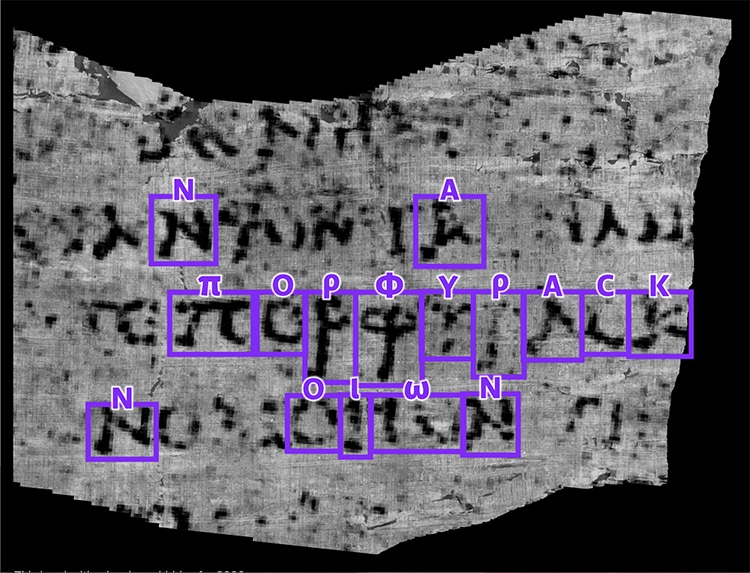
A different ancient scroll burned by the same volcanic explosion. (Photo: University of Kentucky)
Lost libraries hold something of a mystique. The lost library of Alexandria, for example, famously burned in 48 BCE. Similarly, writings to be found in Pompeii and Herculaneum were so charred by the eruption of Mount Vesuvius in 79 CE that they now resumble scroll-shaped lumps of coal. However, due to the preservation effect of the layered ash, these charred remains survived to be excavated in the 18th century. Dreams of reading them may have been unthinkable at that time, but modern artificial intelligence (AI) has vastly expanded the realm of possibility. The Vesuvius Challenge is dedicated to crowdsourcing AI solutions to decipher the scrolls with prize money as an incentive. Thanks to the dedicated and innovative work of several young people, the first word has been deciphered, surprising researchers: “porphyras” meaning purple.
You may be wondering: How can AI read the scrolls? Modern technology has “unfurled them” digitally by using a particle accelerator to collect 3D CT-scans of the scrolls. Computers were cleverly able to unroll them too, creating a landscape of captured texture for study. Ink was detected in crackle patterns, birthing the challenge of finding the words themselves by training algorithms to look for these patterns. College student Luke Farritor has now been announced as the prize winner of the “First Letters Prize.” The achievement is all the more impressive given the fact that ancient Greek writing of the time did not use spaces, and modern letters slightly differ from the ancient. Impressively, another young researcher, Youssef Nader, an Egyptian grad student, shortly after captured the same word in even clearer view. For this, he received a second place monetary prize.
So why does the text say “purple?” Scholars of ancient Greece note that the word rarely appears in ancient texts. A papyrologist told the Vesuvius Challenge, “The sequence πορφυ̣ρ̣ας̣ may be πορφύ̣ρ̣ας̣ (noun, purple dye or cloths of purple) or πορφυ̣ρ̣ᾶς̣ (adjective, purple). Due to the lack of context it is not possible to exclude πορφύ̣ρ̣α ς̣κ [or πορφυ̣ρ̣ᾶ ς̣κ].” These alternative meanings could come from very different texts, so the mystery of the contents only grows stronger. Based on Nader’s decoding, surrounding words might include ανυοντα (ANYONTA, “achieving”) and ομοιων (OMOIωN, “similar”). An amazing aspect of the challenge itself is that submissions are available on GitHub so that people can build on one another’s AI work. Nadar’s model was recently able to offer an incredibly clear view of a broader portion of text, suggesting the story of the scroll is just within reach.
Artificial intelligence breakthroughs by two young researchers have revealed the first word that can be read from the ancient scroll, “Porphyras.”

“Porphyras” means purple. (Photo: Vesuvius Challenge)
h/t: [PopSci]
Related Articles:
‘Vesuvius Challenge’ Will Pay Up to $1M to Whoever Can Decipher Charred Scrolls From Pompeii
The Brilliant History of Books, From Egyptian Scrolls to E-Readers
How a Volcanic Eruption Preserved the Ancient Roman City of Pompeii
